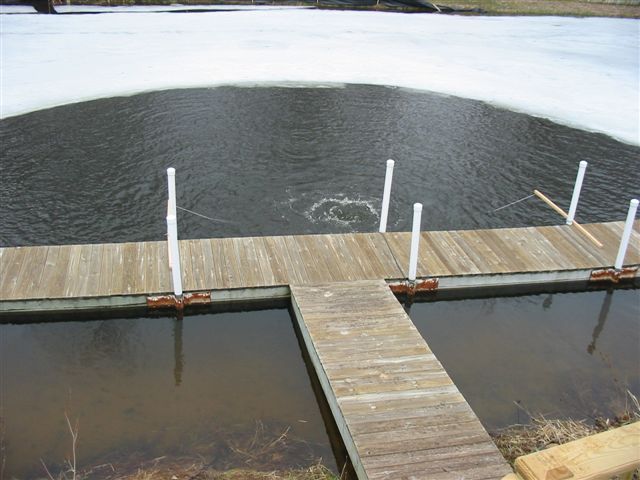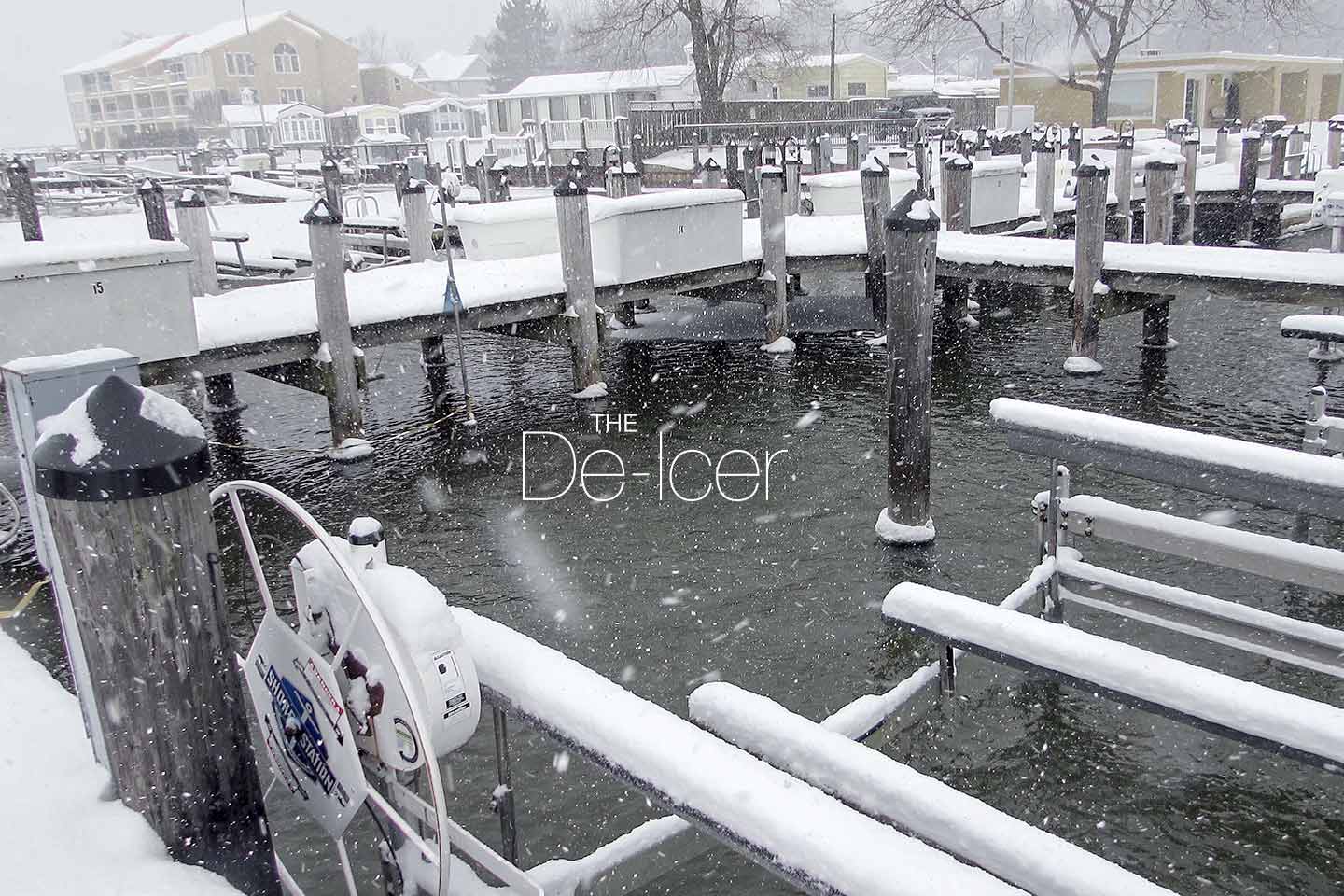Winter Lake de-icing for Docks, Piers, Boats, Marinas, and canals
Wintertime on water bodies presents unique challenges for marinas, piers, docks, canals, and boats. Ice build-up can cause damage or destroy these structures. Unfortunately, it's not always possible to take these objects out of the water. In this blog, we will discuss the types of damage caused by ice to structures, then we will show you solutions to help prevent the destructive force of ice using different types of deicers and bubblers. With any luck, this will save you time and money.
Ice Expansion & Contraction
As Ice freezes, it expands and becomes less dense as a solid, then the water below causing it to float. As the Ice forms into a more massive sheet over time, it becomes vulnerable to expansion and contraction. Temperature plays a significant factor in this. For example, if an ice sheet were uniform with no snow cover, then that ice would contract in colder periods and expand in warmer periods.
Many factors contribute to the expansion and contraction of ice that affect structures in the water. Factors such as wind, underwater springs, sun exposure, water movement, rain, ice thickness, snow cover, and air content all have their unique effects to expansion and contraction. Some of the bigger ones we will look at are wind, water movement, and snow cover.
Snow
By covering the ice, snow intern insulates it from the colder temperatures above, reducing the ability of ice formation. Thinner areas of snow cover will create more ice than thicker snow cover areas, creating a non-uniform sheet of ice. During spring melt, thinner ice breaks up, leaving, the thicker ice chunks free to damage structures from wind or water currents. Uneven snow coverage also affects temperature fluctuations, which cause frequent cracks as pressure and strain are relieved. As the ice cracks, water rushes in freezing, causing the ice to expand toward shore. Although slow it can cause extreme damage to structures over time. This creeping becomes more pronounced in the early spring months due to the increase in temperature fluctuations from the warmer temperatures.
Ice Flow
Once the warmer Spring weather arrives, it starts the process of melting the ice. Ice tends to melt at the edges and moves toward the center. Because ice melts this way, it now allows the larger ice sheets or chunks to move freely in the open water from wind or currents, wind and water current can push the ice into a structure with such destructive force that it can destroy it. As wind drives ice towards shore, it begins to become jammed up. More and more ice will ram into these jams overtaking ice beneath it and causing immense pressures that can snap pilings on piers, obliterate docks out of the water, pulverize boats, and much more. The larger the body of water, the more destructive these flows can be to any structure within it.
Ice Jacking or lifting damage
This phenomenon occurs when ice and water levels fluctuate. Jacking is caused by tides, wind, or when the ice expands and contracts to cause water levels to change. As ice forms around the leg of a pier, for example, it locks in place. As the water level increases, it will force (jack) the leg up. As the water level decreases, the ice surrounding the leg will drop causing it to refreeze around the newly exposed portion of the leg, then as the water level rises again, it jacks the leg upward like using a jack to lift a car. Over time, this can remove the leg from its foundation and cause the upper structure costly damage. We used a pier in this example, but you could see how this destructive force could work on many other types of water structures.
Docks or Marinas on Rivers
Rivers create a unique problem for docks and other structures. Water flows can push large sheets or chunks of ice into your dock like a battering ram! This repeated pummeling can cause significant damage, or can completely destroy the dock. Slower moving currents may build up the ice around your dock, causing strain and pressure overtime, which will cause major damage to your dock.
The De-icer Solution
The best solution, is to remove a structure from the water in the wintertime. But let’s face it, not all structures can be taken out of the water, or you may not have the time, energy, or enough people to remove a dock, boatlift, or other system. The good news is that there are solutions that can help. De-icers are created to combat this problem and designed to protect docks, marinas, piers, boats, and many other structures from the harmful effects of ice. First, let’s explore how de-icers work and then what the different types of de-icers are.
How De-icers work
The concept of how a de-icer works is relatively simple. It takes warmer water from the bottom of a lake or body of water and pushes it to the surface preventing ice from forming. Intern this creates a safe open area that keeps a structure free from the damaging effects of ice.
Types of De-icers: Agitator and Bubbler
Agitator De-icerswork by circulating warm water from below in an agitated motion to the water’s surface, creating a safe open area of water. Different mounting options will allow you to change the head’s angle or the desired direction you wish to push water to keep an area free of ice. Agitator types of de-icers are more aggressive than bubbler de-icers. They work great for driving or deflecting ice away from docks on a river. They prevent damaging ice flows from encroaching on a structure. They can be put in tough to reach spots by using floats, mooring lines, or universal mounts. They are excellent for protecting boats. As an added benefit, de-icersand circulatorscan be used in the summer in a multitude of applications.
Bubbler De-icers,otherwise known as dock bubbler de-icers, work by releasing thousands of tiny air bubbles that carry warmer water from the bottom of the lake to the surface of the lake. This process is also very effective at oxygenating the water, preventing fish die offs. This de-icer style is less aggressive than the agitator de-icers and does not stir the bottom up as much. The Bubbler de-icer works well around boathouses, docks, and other structures on smaller lakes and ponds with less ice flow. If you have a pond with fish and wildlife, this is a highly recommended de-icer. These types of deicers include aeratorsand diffused aerators.
How to effectively use your de-icer
Shallow water
- Using an agitator style of de-icer, direct water from a deeper area and adjust the agitator de-icer head’s angle to push water back to the shallow area of water. Warm water to cold water.
Dock, pier, and shorline de-icing
- In these areas, you want to place your de-icer at an angle that forces water back toward the shoreline. This water intern will flair off the shore, or a retaining wall forming a “T” shape open water pattern. This flair extends the total area of open water, providing more than enough room to keep your dock or pier safe from ice.
Hard to reach areas, tidal changes, and rapid water fluctuations
- A de-icer using mooring lines allows flexibility to place it almost anywhere you need de-icing in unique situations. Tidal changes or areas with rapidly changing conditions are ideal for this type of deicer. They are also used in everyday de-icing situations. Check out the Slinger De-icer from Scott Aeratoror Kasco Marine models 2400D/3400D/4400D available in 120-240V.
Boat de-icing
- When de-icing a boat, you will need to determine if the size is appropriate for one de-icer or multiple de-icers. Generally, you want to start at the bow and angle the flow to follow the boat’s natural contour toward the stern. If the vessel is small enough, one de-icer will do, but a larger vessel may require multiple types of deicers to keep it in open water.
Placing a diffused aerator for de-icing
- In the Winter months, move the aerator to the area you wish to keep protected from ice. For example, you are keeping a dock protected from ice. Looking at Kasco Marines Robust-Aire Diffusers, they will hold a 3-foot diameter area of open water for every 1-foot depth. So 10FT of water depth would create a 30-foot diameter of open water.
Safety First
De-icing is a excellent way to keep your docks or structures free from the damaging effects of ice. But some safety issues come with this. It can be hard to see the edge of ice, causing someone to stumble into open water. Another issue is that the ice toward the edge of the open water can be thinner, making it easy to fall through. It is highly recommended, and in some states, mandated that you use a high visibility fence to prevent people or animals from wandering into a potentially hazardous area. Warning signs and reflective tape or markers will help direct people and snowmobilers out of that area as well, day or night. Other safety considerations are how much open water you wish to have. By this, I mean that you may want the ability to walk onto the ice from your shore. It may not be necessary to have a large area of open water to protect your structure. Large areas can also leave you open to harmful wind effects and flows if you do not have an agitator style de-icer to push away from your dock or structure. And last but of course not least, is to always check with your state rules and regulations. Some states may require permits or have additional rules that you need to comply with.
If your looking for a d-icer that fits your needs make sure to check out our entire de-icer selection. If you need help please call us anytime.
-Justin



